
The Elephanta Caves are a collection of cave temples predominantly dedicated to the Hindu god Shiva, which have been designated a UNESCO World Heritage Site. They are on Elephanta Island, or Gharapuri, in Mumbai Harbour, 10 kilometres (6.2 mi) east of Mumbai in the Indian state of Mahārāshtra. The island, about 2 kilometres (1.2 mi) west of the Jawaharlal Nehru Port, consists of five Hindu caves, a few Buddhist stupa mounds that date back to the 2nd century BCE, and two Buddhist caves with water tanks.
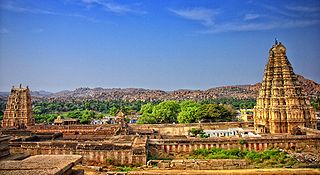
Hampi or Hampe, also referred to as the Group of Monuments at Hampi, is a UNESCO World Heritage Site located in Hampi (City), Ballari district now Vijayanagara district, east-central Karnataka, India. Hampi predates the Vijayanagara Empire; it is mentioned in the Ramayana and the Puranas of Hinduism as Pampa Devi Tirtha Kshetra. Hampi continues as a religious centre, with the Virupaksha Temple, an active Adi Shankara-linked monastery and various monuments belonging to the old city.

Namakkal is a city and the headquarters of Namakkal district, Tamil Nadu. It is the first ISO 14001-2004 certified municipality in Asia for environmental management, specifically the provision and maintenance of water supply, solid waste and sewage management, town planning, lighting and other social services. Namakkal is known as the Egg City due to its large egg production and Transport city.
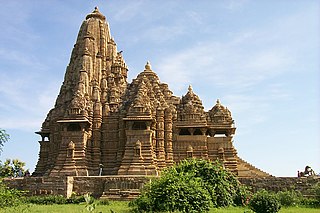
Hindu temple architecture as the main form of Hindu architecture has many varieties of style, though the basic nature of the Hindu temple remains the same, with the essential feature an inner sanctum, the garbha griha or womb-chamber, where the primary Murti or the image of a deity is housed in a simple bare cell. For rituals and prayers, this chamber frequently has an open space that can be moved in a clockwise direction. There are frequently additional buildings and structures in the vicinity of this chamber, with the largest ones covering several acres. On the exterior, the garbhagriha is crowned by a tower-like shikhara, also called the vimana in the south. The shrine building often includes an circumambulatory passage for parikrama, a mandapa congregation hall, and sometimes an antarala antechamber and porch between garbhagriha and mandapa. In addition to other small temples in the compound, there may be additional mandapas or buildings that are either connected or separate from the larger temples.

The Dilwara Temples or Delvada Temples are a group of Śvētāmbara Jain temples located about 2+1⁄2 kilometres from the Mount Abu settlement in Sirohi District, Rajasthan's only hill station. The earliest were built by Bhima I and supposedly designed or at least financed by Vastupala, Jain minister of Dholka. They date between the 11th and 16th centuries, forming some of the most famous monuments in the style of Māru-Gurjara architecture, famous for their use of a very pure white marble and intricate marble carvings. They are managed by Seth Shri Kalyanji Anandji Pedhi, Sirohi and are a pilgrimage place for Jains, and a significant general tourist attraction. The Dilwara temples are regarded as the most impressive among Jain temples in Rajasthan.
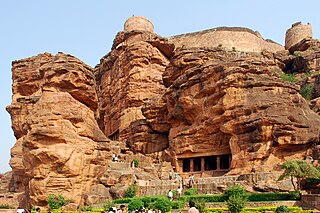
Badami, formerly known as Vātāpi, is a town and headquarters of a taluk by the same name, in the Bagalkot district of Karnataka, India. It was the regal capital of the Badami Chalukyas from 540 to 757. It is famous for its rock cut monuments such as the Badami cave temples, as well as the structural temples such as the Bhutanatha temples, Badami Shivalaya and Jambulingesvara Temple. It is located in a ravine at the foot of a rugged, red sandstone outcrop that surrounds Agastya lake.

Periyar, IPA:[peɾijɐːr], is the longest river and the river with the largest discharge potential in the Indian state of Kerala. It is one of the few perennial rivers in the region and provides drinking water for several major towns. The Periyar is of utmost significance to the economy of Kerala. It generates a significant proportion of Kerala's electrical power via the Idukki Dam and flows along a region of industrial and commercial activity. The river also provides water for irrigation and domestic use throughout its course besides supporting a rich fishery. Due to these reasons, the river has been named the "Lifeline of Kerala". Kochi city, in the vicinity of the river mouth, draws its water supply from Aluva, an upstream site sufficiently free of seawater intrusion. Twenty five percent of Kerala's industries are along the banks of the Periyar. These are mostly crowded within a stretch of 5 kilometres (3 mi) in the Eloor-Edayar region (Udhyogamandal), about 10 kilometres (6 mi) north of Kochi harbor.

Aihole (ಐಹೊಳೆ), also referred to as Aivalli, Ahivolal or Aryapura, is a historic site of ancient and medieval era Buddhist, Hindu and Jain monuments in Karnataka, India that dates from the sixth century through the twelfth century CE. Most of the surviving monuments at the site date from the 7th to 10th centuries. Located around an eponymous small village surrounded by farmlands and sandstone hills, Aihole is a major archaeological site, featuring over 120 stone and cave temples spread along the Malaprabha river valley, in Bagalakote district.

Ranganathaswamy Temple is a Hindu temple dedicated to Ranganatha and is located in Srirangam, Tiruchirapalli, Tamil Nadu, India. Constructed in the Dravidian architectural style, the temple is glorified by the Tamil poet-saints called the Alvars in their canon, the Naalayira Divya Prabhandam, and has the unique distinction of being the foremost among the 108 Divya Desams dedicated to the god Vishnu. The Srirangam temple is the largest temple compound in India and is one of the largest religious complexes in the world. Some of these structures have been renovated, expanded and rebuilt over the centuries as a living temple. The latest addition is the outer tower that is approximately 73 metres (240 ft) tall, it was completed in 1987. Srirangam temple is often listed as the largest functioning Hindu temple in the world, the still larger Angkor Wat being the largest existing temple. The temple is an active Hindu house of worship and follows the Tenkalai tradition of Sri Vaishnavism. The annual 21-day festival conducted during the Tamil month of Margali (December–January) attracts 1 million visitors. The temple complex has been nominated as a UNESCO World Heritage Site, and is in UNESCO's tentative list. In 2017 the temple won the UNESCO Asia Pacific Award of Merit 2017 for cultural heritage conservation, making it the first temple in Tamil Nadu to receive the award from the UNESCO.

Thillai Nataraja Temple, also referred as the Chidambaram Nataraja Temple, is a Hindu temple dedicated to Nataraja, the form of Shiva as the lord of dance. This temple is located in Chidambaram, Tamil Nadu, India. This temple has ancient roots and a Shiva shrine existed at the site when the town was known as Thillai. Chidambaram, the name of the city literally means "stage of consciousness". The temple architecture symbolizes the connection between the arts and spirituality, creative activity and the divine. The temple wall carvings display all the 108 karanas from the Natya Shastra by Bharata Muni, and these postures form a foundation of Bharatanatyam, an Indian classical dance.

Ramappa Temple, also known as the Rudreswara temple, is a Kakatiya style Hindu temple dedicated to the Hindu god Shiva, located in Palamet village, Mulugu district, Telangana, India. It is 15 km (9.3 mi) from Mulugu, 66 km (41 mi) from Warangal, 209 km (130 mi) from Hyderabad. An inscription in the temple says it was constructed in the year 1213 CE by Recherla Rudra—a general of Kakatiya ruler Ganapati Deva. Located in the vicinity of Ramappa Lake, the Ramappa Temple complex which consist of three temples was constructed between 1212 and 1234, designed and architect by Ramappa—after whom the temple complex is named. Marco Polo, during his visit to the Kakatiya empire, supposedly called the temple "the brightest star in the galaxy of temples". In July 2021, Ramappa Temple was declared as a UNESCO World Heritage Site.
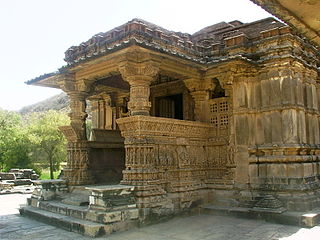
The architecture of the Indian state of Rajasthan has usually been a regional variant of the style of Indian architecture prevailing in north India at the time. Rajasthan is especially notable for the forts and palaces of the many Rajput rulers, which are popular tourist attractions.
Seshachalam Hills are hilly ranges part of the Eastern Ghats in southern Andhra Pradesh state, in southeastern India. The Seshachalam hill ranges are predominantly present in Annamayya and Tirupati districts of the Rayalaseema region in Andhra Pradesh, India.

In Hinduism, the yatra (pilgrimage) to the tirthas has special significance for earning the punya needed to attain the moksha (salvation) by performing the darśana, the parikrama (circumambulation), the yajna, the Dhyana, the puja (worship), the prarthana, the dakshina, the seva, the bhandara, etc. These sacred places are usually located on the banks of sacred waters, such as sacred rivers or their tributaries, the kundas, the ghats, or the stepwells, or the temple tanks.
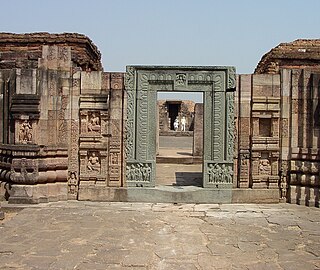
Ratnagiri is the site of a ruined mahavihara, once the major Buddhist monastery in modern Odisha, India. It is located on a hill in between the Brahmani and Birupa rivers in Jajpur district. It is close to other Buddhist sites in the area, including Lalitagiri and Udayagiri, and 100 km (62 mi) from the state capital Bhubaneswar and 70km from the former state capital Cuttack.

The Bhutanatha group of temples are 7th to 12th century Hindu temples to the east of Agastya lake in Badami, Karnataka state, India. It consists of two subgroups – one called the East Bhutanatha group or Bhutanatha main group from 7th to 8th century mostly in the Dravida architecture style; the other called the North Bhutanatha group or Mallikarjuna group from 11th to 12th century mostly in the Nagara architecture. The former illustrates the Badami Chalukya architects, the latter along with the nearby Yellamma temple the Kalyani Chalukya architects.

The Sapta Puri are a group of seven Hindu tirtha, or holy pilgrimage sites, located in India. Pilgrimage to these sites is said to bless the pilgrim with moksha.

The Chalukya Shiva Temple, dedicated to Shiva, is one of the oldest Hindu temples and is located in the group of monuments at Aihole in the state of Karnataka, India. Formerly dated to the 7th or 8th century, it is now dated to about the 5th century. It is located to the south of the Durga temple, Aihole.

Chaya Someswara Temple, also known as Chaya Someshvara Swamy Alayam or the Saila-Somesvara temple, is a Saivite Hindu temple located in Panagal, Nalgonda district of Telangana, India. It was built around the mid 11th-century during the rule of the Kunduru Chodas, supported and embellished further by later Hindu dynasties of Telangana. Some date it to late 11th to early 12th-century.

Māru-Gurjara architecture or Solaṅkī style, is the style of West Indian temple architecture that originated in Gujarat and Rajasthan from the 11th to 13th centuries, under the Chaulukya dynasty. Although originating as a regional style in Hindu temple architecture, it became especially popular in Jain temples, and mainly under Jain patronage later spread across India, then later to diaspora communities around the world.


























